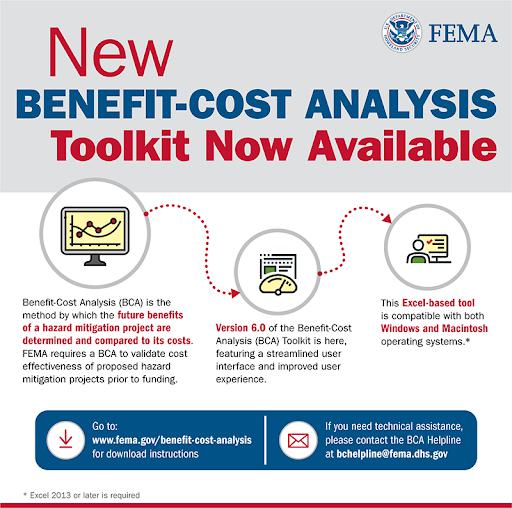SIGN UP TODAY: Expert advice to help you take advantage of the BCAs related to FEMA's grant funding
Benefit-Cost Analysis & Benefit-Cost Ratio

The Federal Emergency Management Agency (FEMA) Benefit-Cost Analysis (BCA) is the method used to determine the future benefits of a hazard mitigation project as it relates to the overall cost to complete the project. This total cost is referred to as a Benefit-Cost Ratio (BCR), which is calculated by a project’s total benefit outcome in dollars divided by its total costs. The BCR is utilized to depict the "cost-effectiveness" of a project, which is considered to be cost-effective when the BCR is calculated at 1.0 or greater. This cost-effectiveness shows the benefits of a prospective hazard mitigation project are sufficient to justify the costs.
Furthermore, FEMA requires the BCA to validate cost effectiveness of proposed hazard mitigation projects prior to funding. There are two drivers behind this requirement: (1) the Office of Management and Budget’s (OMB) Circular A-94 Revised, “Guidelines and Discount Rates for Benefit-Cost Analysis of Federal Programs” and (2) the Stafford Act.
The application window for FEMA grant funding is time sensitive, so it is important to understand all facets of the project should it be approved. BCAs are a component of the grant funding from your state, territory, tribal and/or local government. Witt O'Brien's team of BCA Subject Matter Experts will guide you to get the BCR over 1.0 -- even for the most challenging applications.
Visit FEMA's BCA website for general information on BCAs. Also check out FEMA's BCA Toolkit Version 6.0 User Guide for additional detailed information.
Expert Guidance
Witt O'Brien's hosted an informational webinar presented by Juan Bossano, our Director of Mitigation Operations, that touched on both the basics as well as complex features of FEMA’s BCA at the end of 2019. The webinar provided an explanation of the key elements needed to complete a BCA. Given FEMA requires each mitigation application to prove cost-effectiveness through a BCA, it's a critical component of any application. Achieving a Benefit-Cost Ratio (benefits divided by costs) greater than 1.0, as is required to be considered for funding, can often be a challenge.
We are happy to discuss strategies and project options for your community to help ascertain funding from FEMA and assess your project's cost-effectiveness. If you are struggling with the ongoing development of disaster-related Hazard Mitigation Grant Program (HMGP) project applications or implementation, contact us for advice today. Our seasoned team of experts are ready to help make your community more resilient.

Juan Bossano - Director, Mitigation Operations
Juan is an experienced disaster recovery and hazard mitigation specialist. He has assisted communities, non-profits, tribes, and state agencies in all aspects of recovery from Public Assistance (PA), Community Development Block Grant Disaster Recovery (CDBG-DR) and Hazard Mitigation Assistance (HMA) grant programs, particularly the Hazard Mitigation Grant Program (HMGP).
Following some of the most recent US disasters, Juan has guided states, cities, towns, nonprofits and homeowners in accessing more than $1B for their recovery and resiliency requirements. He is an expert in application development, including cost-effectiveness determinations, benefit-cost analysis, Stafford Act 404 and 406 and 44 CFR. He also possesses knowledge of floodplain management, flood hazard mitigation, National Flood Insurance Program and flood preparedness, warning and recovery.
Image Sources: FEMA.gov
